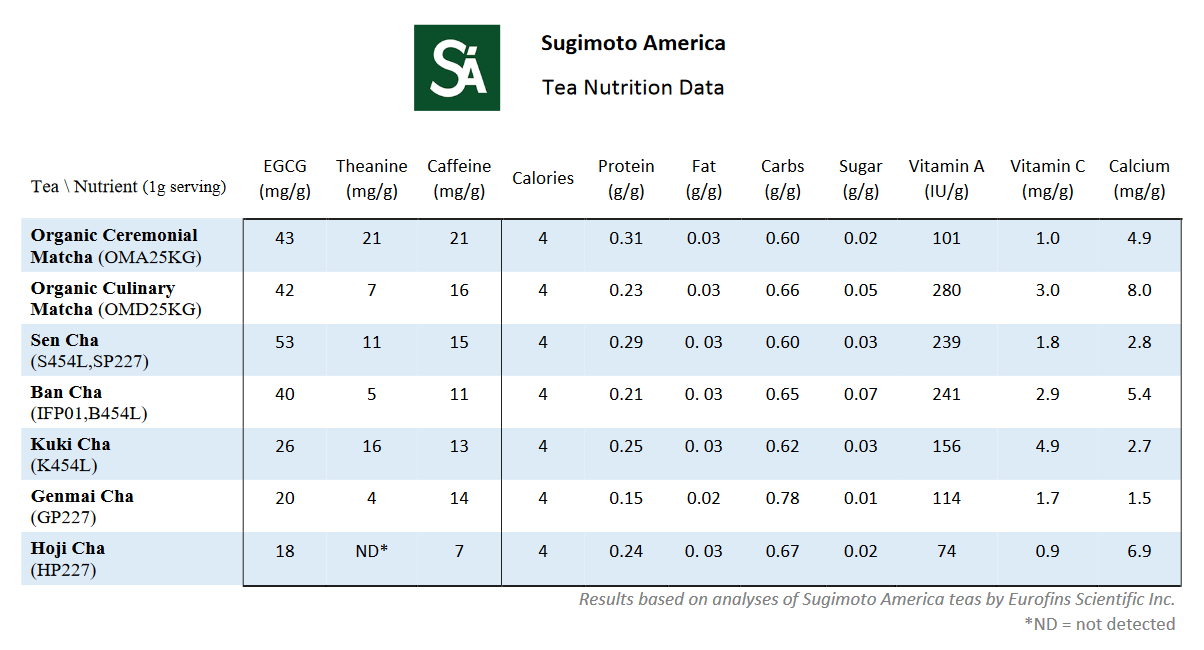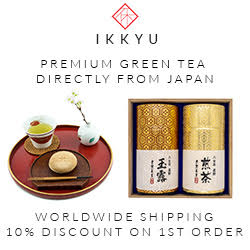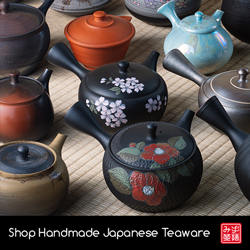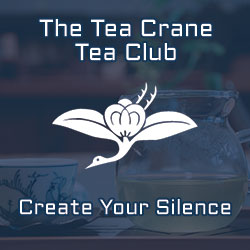Sugimoto America tested some of their teas for different nutritional compounds, and they have shared the results.
I think that it’s a good opportunity to discuss some of the findings.
 The chart compares one gram of each tea. Note that it’s not brewed tea.
The chart compares one gram of each tea. Note that it’s not brewed tea.
Results can vary depending on many factors, but this can give us a general idea.
Let’s concentrate on EGCG, theanine, and caffeine. The rest of the values are very small, so they are not really significant for practical purposes, unless you want to eat 100 grams of tea leaves in one sitting, which I strongly advise you not to do.
EGCG level’s don’t correlate with green tea quality
A ceremonial matcha can have the same EGCG as a culinary one, and the lowly bancha may not be far behind.
This also makes sense in terms of taste. Having more catechins, although making a tea healthier, also make it more astringent and bitter.
It’s interesting that genmaicha and houjicha are both low in EGCG.
Genmaicha contains rice, which has no catechins so it’s no wonder. In the case of houjicha, it seems that roasting has a considerable effect.
This results are also supported by a study in 2010, which is shown in page 9 of the Nihoncha Instructor course book, volume II. The higher the quality of sencha and gyokuro, the lower the catechin content.
Amino acids make a good Japanese tea
Why are matcha and gyokuro shaded? To make a tea with a high amino acid content.
Tea leaves from earlier harvest also have more amino acids. That’s why a tea from the first harvest tastes better than the rest, and why sencha is more expensive than bancha.
In the case of matcha, a ceremonial one is made with a better harvest than a culinary one. Thus, the better matchas have more amino acids as well.
Genmaicha, houjicha and bancha are low grade Japanese teas. As you can see in the chart, they are also low in L-theanine.
As a side note, kukicha is high in L-theanine because stems are particularly rich in it.
Houjicha is pretty much a decaffeinated green tea
I haven’t been able to find the exact scientific explanation of why houjicha is low in caffeine.
It’s commonly said that the roasting process decreases the caffeine content. Another aspect is that houjicha is often just a roasted bancha, and bancha has low caffeine levels to start with.
The younger the tea leaf, the more caffeine it contains.
Finally there’s the aspect of the brewed tea.
Which liquid tea has more nutrients?
In this case matcha is the definite winner. You get pretty much all of what the dry tea contained.
In loose leaf teas, unless you ate the tea leaves, some nutrients remain in the wet leaves. Beta-carotene and vitamin E, for example, aren’t soluble in water so you can’t obtain them from an infused tea.
Matcha isn’t rich in nutrients just for being matcha, but for being a powdered tea.






August 16, 2016
Why are we all not eating our leafs all the time? Have you ever tried to grind or mix the tea with the leafs into a matcha-like stew?
August 16, 2016
Hi Nikola
I have used the spent leaves for cooking purposes, and sometimes eat the tea leaves if they are high quality, for example a shincha or a gyokuro.
But not always. Sometimes I just want to enjoy the brewed tea.
August 16, 2016
Very interesting, Ricardo, thanks for sharing!
And I am reading right now a very funny book (it’s a PDF file), a Japanese book about tea for children. It’s definitely much easier than your Nihoncha Instructor books, I bet 🙂 But anyway, it contains a LOT of useful information with wonderful pictures and explained in the most clear way 🙂
http://www.ocha-festival.jp/pdf/ocha_dic.pdf
August 16, 2016
Hi Valeria
Thanks for the link, I will read it too. It looks interesting 🙂
October 19, 2016
Thank you for such an informative blog on green teas. I enjoy it immensely. Based on graph, it seems bancha contains more benefits, but you concluded that matcha has more nutritional value. I wonder about that.
October 19, 2016
Hello Faro
The chart is not for brewed tea. If it were brewed, the values for brewed teas would be very low, because nutrients remain in the wet leaves even after multiple infusions.
So for bancha, if you want all the benefits you would have to eat the leaves or grind it into power, which would be very bitter. Healthwise it would be very good, though.
July 15, 2019
How could genmaicha possibly have more caffiene than bancha, when bancha is 50% toasted rice? That makes no sense! Also, the idea that it only has 20% less theanine seems unlikely as well unless they used a very different bancha in the genmaicha.
July 15, 2019
Hi Paul
The tea leaves that Sugimoto Tea uses in their genmaicha is actually a second harvest sencha. So it’s not the same as the average genmaicha.
July 15, 2019
Ah very interesting, thank you for your reply! I have seen very wide ranges of theanine and caffeine for all these types of tea, including matcha (as well as the ratio of theanine : caffeine). It makes me wonder if either the various labs testing them have a large range of accuracy, or if the particular plant (and farm) matters significantly more than the type of tea.
In the latter case, the only way to have a good sense of what you’re getting would be if each batch from each season was tested, and the results were published (as well as using different brewing methods). Probably unlikely to happen.
Thank you for this site by the way! Although I have been drinking green tea sporadically for many years, I’m just starting to get serious about learning and trying each different kind. I’m part Japanese (and also part Hispanic and Italian), so it’s helping me to connect with one of my native cultures.
July 15, 2019
There are many factors, for example amount of fertilizer plays an important role in l-theanine levels, also amount of sunlight.
Good to hear that you are getting serious about your green tea education : )
Please email me if you have any questions regarding Japanese green tea.
May 28, 2024
Hi Ricardo,
I am looking for a tea that is low in EGCG. I no longer drink matcha or sencha due to the high EGCG content and am looking for alternatives. Would kukicha be lower in EGCG than hojicha?
Thank you for your insight!
May 29, 2024
Hi Patricia
Houjicha would be lower than kukicha. Or you can also go with bancha and genmaicha instead of sencha.